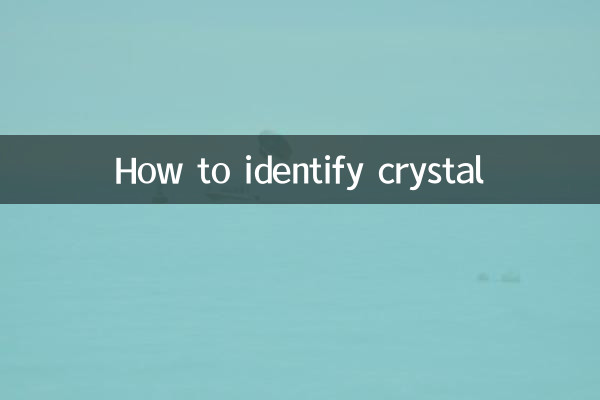How to identify crystal
As a natural mineral, crystal is deeply loved by people because of its beautiful color and unique energy properties. However, the market is full of artificial or imitation crystals, and how to distinguish between true and false has become a concern for many consumers. This article will combine popular topics and hot content in the past 10 days to introduce you in detail the identification method of crystals and provide structured data for reference.
1. Basic characteristics of crystal

Natural crystals usually have the following characteristics:
| feature | describe |
|---|---|
| hardness | Mohs hardness is 7, and can't be cut with a knife |
| temperature | Cool and slow heat dissipation |
| Inclusions | Natural crystals usually contain bubbles, cracks or mineral inclusions |
| luster | Glass gloss, high transparency |
2. Common ways to identify crystals
1.Observation method: Natural crystals usually have naturally formed textures and inclusions, while artificial crystals are too perfect and lack a natural feel.
2.Touch method: Natural crystals feel cold and dissipate slowly; glass or plastic imitations will heat up quickly.
3.Lighting method: Put the crystal under strong light to observe, natural crystals will have slight optical effects, such as rainbow or birefringence.
4.Hardness test: Natural crystal has a high hardness and can't be cut with a knife; while glass or plastic is easily scratched.
| method | Natural crystal | Artificial crystal |
|---|---|---|
| Observation method | With natural textures and inclusions | Too perfect, lacking natural feeling |
| Touch method | Cold and slow heat dissipation | Rapid heating |
| Lighting method | Have an optical effect | No special optical effects |
| Hardness test | Not easy to be scratched | Easy to be scratched |
3. Identification techniques for popular crystal varieties
1.Amethyst: The color distribution of natural amethyst is uneven and has a slight blue or red tone; while the color of artificial amethyst is too uniform.
2.Pink crystal: Natural powder crystals usually have white or cloud-like inclusions; while artificial powder crystals are too transparent.
3.Citrine: Natural citrine has a lighter color and a slight green tone; while artificial citrine has a bright and uniform color.
4.White crystal: Natural white crystals usually have slight inclusions or cracks; while artificial white crystals are completely transparent.
| variety | Natural features | Artificial features |
|---|---|---|
| Amethyst | Uneven color, with blue/red tones | Even color |
| Pink crystal | There are white or cloudy contents | Too transparent |
| Citrine | Lighter color, green tone | Bright and even color |
| White crystal | There are slight inclusions or cracks | Completely transparent |
4. How to avoid buying fake crystals
1.Choose a regular merchant: When buying crystals, try to choose a reputable merchant and avoid purchasing at roadside stalls or online stores of unknown origin.
2.Request for an appraisal certificate: High-quality natural crystals are usually equipped with professional certification certificates, and consumers can ask the merchant to provide them.
3.Price reference: Natural crystals are priced at a high price. If you encounter products that are too low, you should be wary of whether they are imitations.
4.Learn basic knowledge: Understanding the basic characteristics and identification methods of crystals can effectively avoid being deceived.
Summarize
The identification of crystal requires comprehensive use of observation, touch, light and other methods, and the characteristics of different varieties are judged. Through the structured data and techniques introduced in this article, I believe you can better distinguish between real and fake crystals and avoid purchasing imitations. If you still have questions about the identification of crystals, it is recommended to consult a professional appraisal agency or senior collector.

check the details

check the details